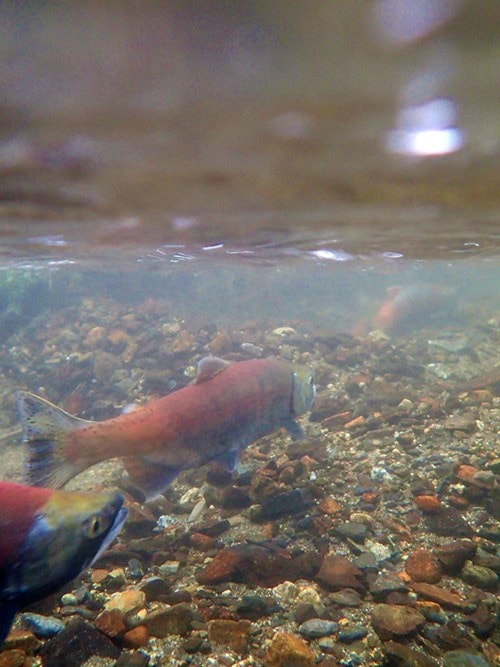It’s an off-year for pink salmon and perhaps a few weeks too early for the chums — but the Kawkawa Lake kokanees are putting on their fall colours for their annual spawn.
Take a stroll along Kawkawa Lake Road on the east side of the lake and you’ll soon see the bright red fish with green heads, spawning in the streams that feed into the lake. Between Camp Kawkawa and Summer Road, it’s about a one-kilometre round trip. If you only have a bit of time, focus more on the streams between Stephens and Summer roads.
These fish are a miniature version of sockeye salmon, that behave as if they are land-locked — even though Kawkawa Lake has a route to the Pacific Ocean. Because they stay in fresh water for their entire lives, they don’t encounter the richer food sources of the ocean and their size is thus limited.
Like their ocean-bound cousins, the kokanee show the distinctive red and green colouring when they are in spawning mode, the last phase of their lives. The female fish retain their basic shape, while the males develop a humped back and an aggressive-looking snout and jaw.
While you’re watching, a female may turn on her side and use her tail fin to dig a bed, called a redd, for her eggs. After the eggs are deposited, a male will move in to fertilize the eggs and the female will come back to cover the eggs.
Keep a sharp eye and you may see a few eggs get swept away by the current. These will not survive — but will be a snack for a bird or other species of fish, downstream.
Greig Bethel, media relations officer for the Ministry of Forests, Lands and Natural Resource Operations, said on Tuesday that the life cycle of kokanee and ocean-run sockeye is very similar. Most kokanee spawn after three years, some after four, similar to sockeye salmon.
“Additional stocks of kokanee were added to the lake in 1960, but there was a smaller indigenous population present before that,” said Bethel. “Staff can’t confirm what exact numbers were like before the additional stock was added, but the introduced fish took nicely to the lake and have provided a self-sustaining population of good sized kokanee that have been popular with anglers.”
Kawkawa Lake resident Jean Stephens has been living there since 1955, when she moved there with her husband, Gordon. She said Gordon’s parents, Fred and Louise, moved to the second beach area in 1950 and built the road that bears the family name.
Stephens hadn’t gone out to check on the water after Tuesday night’s heavy rains but she didn’t think the kokanee or their eggs would be in any peril.
“The streams don’t normally change much after a heavy rain. They stay pretty steady,” she said.
Retired wildlife officer and long-time Hope resident Jack DeLair spoke enthusiastically about the spring-fed waterways on the east side of the lake.
“It’s clean, clear water — a wonderful aquifer!” he said, Wednesday.
Bethel added, “Cutthroat trout are present in the lake, and it is assumed they spawn in the tributaries. Rainbow trout are also present in smaller numbers in the lake. Once again, it is assumed they spawn in the tributaries or, possibly, the outflow stream. Different salmon species also spawn in the lake’s tributaries.”
Before you head down to see the spawners, choose your clothes wisely. Red or fluorescent colours would be your worst choices.
“Fish can be startled by bright colours,” said Bethel, “…a reason anglers often wear subdued tones.”
Remember to respect private property and not disturb the fish or their habitat.
For anyone interested in photography, capturing images through shiny surfaces — such as water — can be enhanced by using a polarizing filter or by shooting in shaded areas. These both cut down on light to your camera’s sensor, however, so you have to increase your ISO or aperture settings to maintain a suitable shutter speed.
